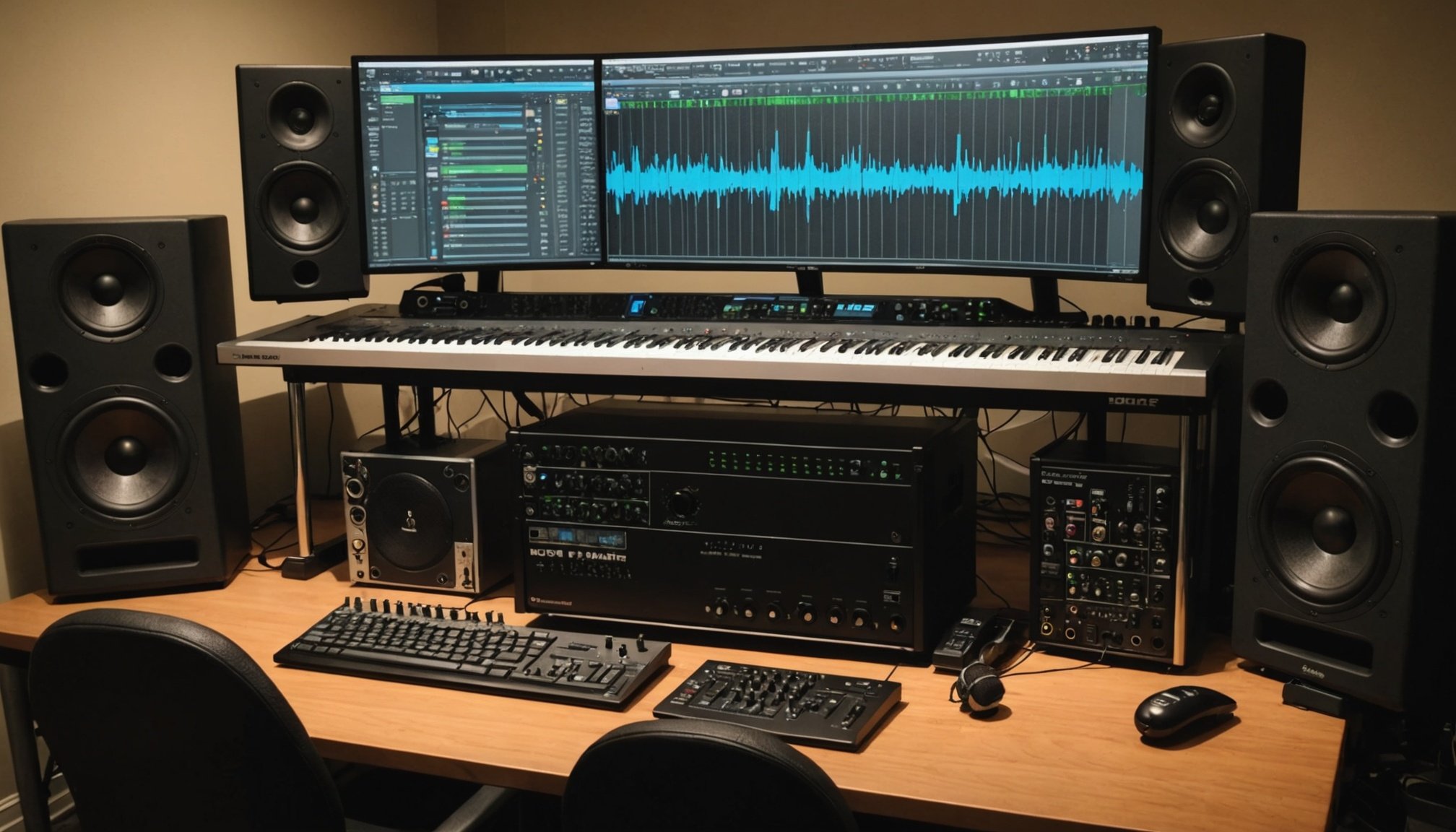Ultimate Guide to Silencing Your Home Recording Studio Using a Tailored PC Configuration
Setting Up Your Home Studio for Silent Recording
When it comes to setting up a home recording studio, one of the most significant challenges many musicians and producers face is the issue of noise. Whether you’re practicing late at night, recording in a shared living space, or simply trying to maintain a peaceful environment, silencing your home studio is crucial. Here’s how you can achieve high-quality, silent recording using a tailored PC configuration and the right equipment.
Choosing the Right Instruments for Silent Practice
The first step in creating a silent home studio is to select instruments that are designed for quiet operation. Companies like Yamaha have revolutionized the concept of silent practice with their extensive line of SILENT™ instruments.
Also to discover : Mastering Guest Wi-Fi Security: Your Comprehensive Step-by-Step Manual for Google Nest Wi-Fi
-
SILENT Piano™: These pianos look and feel like traditional acoustic pianos but can be switched into Silent mode, where the hammers stop hitting the strings, and the sound is heard only through headphones. This is made possible by optical sensors that measure the nuances of the playing and trigger digital sounds[1].
-
SILENT Guitar™: These guitars use a special pickup to replicate the sound of an acoustic guitar digitally, eliminating the need for a resonant body. This makes them ideal for silent practice and travel due to their collapsible design[1].
In the same genre : Ultimate guide to boosting home network security with the netgear orbi rbk50 mesh system
-
SILENT Brass™: For brass instruments, Yamaha’s SILENT Brass system uses a mute fitted with a pickup that connects to a small electronic unit, simulating the standard acoustic tone without the volume[1].
-
Digital Saxophone: The Yamaha YDS-150 Digital Saxophone offers a realistic playing experience with 73 onboard sounds and a headphone jack, allowing saxophonists to practice silently[1].
Optimizing Your PC Configuration for Audio Quality
Your PC configuration plays a critical role in ensuring high-quality audio recording and mixing. Here are some key components and software to focus on:
Audio Interface
An audio interface is the heart of your recording setup, connecting your instruments to your computer and ensuring high-quality sound.
| Audio Interface | Key Features | Price Range |
|---|---|---|
| Focusrite Scarlett | High-resolution converters, low latency | $100-$300 |
| PreSonus AudioBox | USB connectivity, phantom power | $100-$300 |
| Native Instruments Komplete Audio 1 | High-end converters, MIDI interface | $500-$600 |
When choosing an audio interface, make sure it supports the number of inputs you need and has the right connectivity options for your instruments.
Recording Software
The right recording software can make a significant difference in the quality of your recordings and the ease of your workflow.
- DAW (Digital Audio Workstation) Options:
- Ableton Live: Known for its live performance capabilities and intuitive interface.
- Logic Pro X: A professional DAW with a wide range of plugins and tools.
- FL Studio: Popular among electronic music producers for its beat-oriented workflow.
"Choosing the right DAW is like finding the right instrument; it needs to feel right for your music production needs."
Studio Monitors and Headphones
Accurate sound reproduction is essential for mixing and mastering your music.
- Studio Monitors:
- Yamaha HS Series: Known for their flat-frequency response and clear sound.
- Adam Audio: Offers detailed and accurate sound reproduction.
- Headphones:
- Sennheiser HD 280 Pro: Clear, flat response ideal for mixing.
- Audio-Technica M50x: Industry standard for accurate sound reproduction[2].
Managing Cables for Optimal Sound Quality
Proper cable management is often overlooked but is crucial for maintaining sound quality and ensuring safety in your home studio.
Cable Organization Tips
- Separate Audio and Power Cables: Prevent unwanted noise and interference by keeping audio cables away from power cords[4].
- Use High-Quality Shielded Cables: Minimize noise pickup and ensure consistent performance[4].
- Avoid Sharp Bends and Tangling: Use cable ties and organizers to maintain optimal cable positioning[4].
Here are some quick cable setup and teardown techniques:
- Use Cable Reels or Spools: For quick deployment and easy winding.
- Employ the Over-Under Coiling Technique: Prevent cable kinks and tangles.
- Use Velcro Ties or Cable Straps: Bundle cables neatly without damaging them[4].
Mixing and Mastering for Professional Sound
Once you’ve set up your studio and recorded your tracks, the next step is to mix and master your music for the best possible sound quality.
Cleaning Up and Editing Audio
Cleaning your audio tracks is critical for a professional mix.
- Remove Noise and Undesired Silence: Use editing tools to remove any noise, clicks, or undesired silence from your tracks[2].
- Edit Timing: Ensure rhythmic elements like drums and vocals are pristine and consistent[2].
Equalization (EQ) and Compression
EQ and compression are pivotal tools in mixing.
-
EQ Settings:
-
Low Frequencies (< 80 Hz): Boost for warmth.
-
Low-Mid Frequencies: Cut if necessary to reduce muddiness.
-
High-Mid Frequencies: Boost for clarity.
-
High Frequencies (> 5 kHz): Gentle boost for air[2].
-
Compression Settings:
-
Vocals: Threshold -20 dB, Ratio 3:1, Fast attack, Medium release.
-
Drums: Threshold -10 dB, Ratio 4:1, Medium attack, Medium release[2].
"EQ and compression are like the seasoning in your favorite recipe; they make the dish come alive."
Reverb and Delay
Reverb and delay add depth and space to your mix.
-
Reverb Settings:
-
Plate Reverb: Medium room size, 30 ms pre-delay, 1.5 s decay time.
-
Hall Reverb: Large room size, 50 ms pre-delay, > 2 s decay time[2].
-
Delay Settings:
-
Tape Delay: 30% feedback, 1/4 note delay time, High-pass filter.
-
Analog Delay: 25% feedback, 1/8 note delay time, Low-pass filter[2].
Final Tips for a Professional Home Studio Setup
Here are some final tips to ensure your home studio setup is optimized for silent and high-quality recording:
- Invest in Quality Equipment: High-quality instruments, audio interfaces, and software make a significant difference in sound quality.
- Use the Right Software Tools: Familiarize yourself with your DAW and use plugins and tools effectively to enhance your mix.
- Practice Regularly: The more you practice, the better you’ll become at setting up and using your home studio.
"A well-set-up home studio is like having your own personal sanctuary for music creation; it's where your best work comes to life."
Creating a silent and high-quality home recording studio is achievable with the right equipment, software, and practices. By choosing silent instruments, optimizing your PC configuration, managing cables effectively, and mastering mixing and mastering techniques, you can ensure that your music production meets professional standards without disturbing others. Whether you’re a seasoned musician or just starting out, these tips will help you set up a home studio that allows you to focus on what matters most – your music.
Practical Insights and Actionable Advice
- Start Small: Begin with the basics and gradually upgrade your equipment as you become more comfortable with your setup.
- Experiment: Don’t be afraid to try different settings and techniques to find what works best for your music.
- Invest in Education: Watch tutorials, read guides, and take courses to improve your skills in music production.
By following these guidelines, you’ll be well on your way to creating a home studio that not only meets your needs but also enhances your overall music production experience. Happy recording











